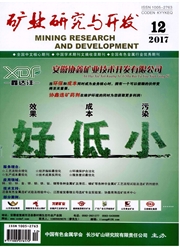

 中文摘要:
中文摘要:
在应用无底柱分段崩落法的金属矿山,倾斜矿体的矿石损失率高达15%~25%。实验研究了进路回采后矿石残留体位置与形态,针对放矿残留体和本分段未崩落的间柱及未崩落的下盘三角矿等下盘残留体,提出了利用移动方程圈定迁移残留体的方法,以及主矿体回采后在下盘(或底板)开拓回采进路二次回采残留矿量的方法,并在符山铁矿采用两条进路之间重新布置小尺寸回采进路的方式,有效回采了4476t采场下盘残留矿量。
 英文摘要:
英文摘要:
In the metal mine applying non-pillar sublevel caving method, the recovery drift is usually set in footwall , but the loss rate of inclined ore is as high as 15%-25% according to the ore reserves and production quantity calculation, which needs sec- ondary recovery. The experiment researched the site and shape of the residual ore after mining from footwall recovery route, and the results revealed that the residual ore was within three boundaries: two adjacent routes, this sublevel floor and the upper sublevel floor, as well as the extraction boundary in this sublevel and the interface between ore and rock in lower footwall. The whole residual ore was composed of three parts including migration residual ore which was the main part of residual ridge, non- caved column between the two adjacent routes, and non-caved triangle ore. Therefore, two methods were proposed as follows. The migration residual ore could be delineated with granular moving equation, and the whole footwall residual ore could be mined by digging routes in the footwall(or floor). In Fushan Iron Mine, these methods were adopted, a small size recovery route was dug between two adjacent routes, and the recovery effect was significant.
 同期刊论文项目
同期刊论文项目
 同项目期刊论文
同项目期刊论文
 期刊信息
期刊信息
